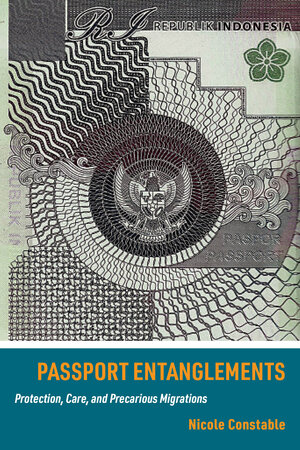By Nicole Constable, author of Passport Entanglements: Protection, Care, and Precarious Migrations
Since the 1990s, I have done field research in Hong Kong among Filipino and Indonesian migrant workers and activists, most of whom worked as domestic workers caring for children, the elderly, and their employer’s households. Before the Covid-19 pandemic, there were over 400,000 foreign domestic workers in Hong Kong. Over half were Filipino and just under half were Indonesian.
For years I was puzzled by the fact that when I asked Indonesian women their names and ages, many replied, “Do you want my real name, or the one in my passport”? It wasn’t until 2015 when Hong Kong’s Indonesian consulate introduced new biometric requirements for passport renewal, requiring all renewals to be done in person and not through employment agents, that I learned about the existence of aspal documents. In Bahasa Indonesia, aspal passports are asli tapi palsu— literally “real but fake” passports.
A third or more of the Indonesian workers in Hong Kong have aspal passports with inaccuracies in their names, places of origin, or birthdates. But the passports themselves are “authentic” in the sense that they are state produced. Ultimately the new renewal policy resulted in thousands of Indonesian workers returning home, others going on trial, and some being charged with immigration fraud and serving prison time.
Passports are the focus of Passport Entanglements, the latest of three books that I have written about the lives and experiences of Filipino and Indonesian migrant domestic workers. I structure the book around common binaries and seemingly intuitive distinctions that I aim to disrupt. Theoretically and ethnographically, I show how troubling each binary relevant to these passports critically extends the picture of labor migration across temporalities and scales. For example, one key binary focuses on the provision of “care and control” provided by and to migrant workers, and enacted on them. Passports both facilitate the care work that these workers provide and are considered a means to secure the care and protection of these workers. However, control does not always mean care, and many workers’ difficulties are tied to their identities as migrant women workers, as literally encoded in their passports.
The central “real and fake” binary of the book shows how aspal passports came about as young women sought to work abroad or were pressured to do so. The profit-seeking recruitment industry these women relied on needs government officials to produce “real” passports that contain “fake” data, thus facilitating the control and exploitation of workers. This entanglement of “state and society” illustrates the production, uses, and meanings of passports in relation to the nation-state, and the history of labor control and exploitation in Indonesia. Additionally, pairings of “citizen and migrant” create and reinforce presumed oppositions between insiders and outsiders —or locals and foreigners— within a migratory context.
Instead of reinforcing these binaries, I show what is gained by seeing workers and employers as both citizens and migrants. Migrant worker activists fought against the new passport renewal policies as both citizens and migrants. They successfully halted a process that had dire consequences for women who were tried and sent to prison in Hong Kong for immigration fraud, despite the many reassurances they had received over the years about there being “nothing wrong” with their aspal passports.
In an age of new and unprecedented forms of human mobility, especially feminized labor migration in and from regions of Asia, passports offer insights on the many historical and contemporary links between labor control and migration, and migrant worker resistance and precarity. The bureaucracy of passports brings to light global “best practices” intended to prevent terrorism and human trafficking, as well as state and local policies pertaining to national security. The so-called care and protection of migrant workers has shaped the deployment of contemporary biometric technologies in travel documentation. In Indonesia specifically, the growing relationship between the expanding and highly profitable labor recruitment industry and the state cannot be ignored. Moreover, historical and colonial patterns and policies of labor mobility are entangled in contemporary patterns of poverty and labor migration, especially from East and Central Java. Individuals’ experiences of migration, especially for Javanese women with aspal documents, involve local networks of brokers and agents who “helped” them to obtain birth certificates and other documents that are required to obtain a passport to work abroad. Young women thus become dependent on the low-level recruiters and their corrupt partners in regional passport issuing offices, and official recruitment agencies that are required to broker work abroad. Along the way, would-be workers become economically indebted to the recruiters and agencies who facilitate their training and travel to work abroad. They must then repay the agency fees and other costs of migration when they get to Hong Kong, through affiliated loan agencies, whose agents often take their passports and most of their income for seven months of their two-year contracts as collateral.
Overall, this story shows the legacy of labor control and labor mobility practices across colonial and postcolonial times. The specifics of the documents, the types of labor, and the destinations have changed, but the colonial forms of precarity echo earlier ones: As women are pressured or coerced to travel with aspal documents and then blamed and punished for using them, those who issued them and profited most from them are largely left free of blame. Such patterns raise questions about the temporal relationships amongst slavery, indentured labor, and debt bondage. Passports also remind us not to ignore the links between small Javanese villages, midsize towns, cities, nation states and global patterns and policies pertaining to the control of labor and mobility in and beyond Asia.
Visit our 2023 AAS virtual exhibit to get 40% off the book
.

